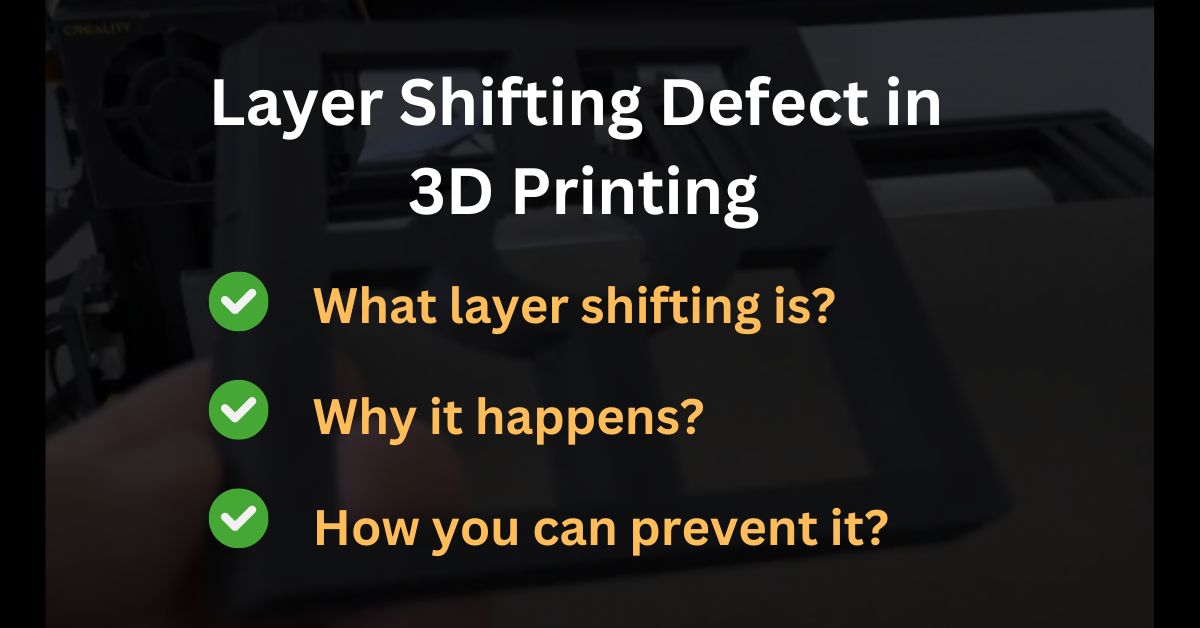One common issue that can ruin a 3D print is layer shifting. This defect can make an object look misaligned and unusable. In this blog post, I will discuss what layer shifting is, why it happens, and how you can prevent it.
Fused Deposition Modeling (FDM) is one of the most widely used 3d printing techniques, known for its simplicity and versatility. The only challange you have to face while 3d printing is handeling its defects.
I have written an extensive article coving all the defects in fdm 3d printing. You must check it our here, so you can avoid all of them –> common defects in fdm 3d printing.
What is Layer Shifting?
Layer shifting occurs when the layers of a 3D print do not align properly. Instead of stacking neatly on top of each other, one or more layers shift to the side, causing the entire print to become misaligned. This can result in a skewed or slanted object that is far from the original design.
Why Does Layer Shifting Happen?
Layer shifting is typically caused by mechanical or electrical issues with the 3D printer. Some of the most common reasons for layer shifting include:
- Loose Belts or Pulleys: In an FDM printer, belts and pulleys control the movement of the print head or hot end. If they are loose or not properly tensioned, they can slip, causing the print head to move incorrectly and leading to layer shifting.
- Stepper Motor Problems: The stepper motors are responsible for moving the print head and the build plate. If a motor skips steps due to too much resistance, overheating, or lack of power, it can cause the layers to shift.
- Physical Obstructions: Sometimes, debris or an obstacle in the printer’s path can cause the print head to hit something and shift the layers.
- Print Speed: Printing too fast can cause the printer to lose steps, especially if the motors or belts can’t keep up with the rapid movements, leading to layer shifting.
- Firmware or Software Issues: Incorrect settings in the printer’s firmware or slicing software can also cause the printer to behave unpredictably, resulting in layer shifts.
How to Prevent Layer Shifting
Preventing layer shifting involves checking and maintaining your 3D printer regularly. Below are some steps you can take to avoid layer shifting:
- Check and Tighten Belts: Regularly inspect the belts and pulleys in your printer to ensure they are tight and properly aligned. Tighten any loose belts and make sure the pulleys are secure.
- Monitor Stepper Motors: Make sure the stepper motors are not overheating and are functioning correctly. If you notice any unusual noises or movements, consider reducing the print speed or checking the motor drivers.
- Clear the Print Area: Keep the print bed and surrounding area clear of debris. Make sure there are no obstacles that could interfere with the movement of the print head.
- Adjust Print Speed: If you experience layer shifting, try reducing the print speed. This can help the printer maintain accurate movements and prevent layer misalignment.
- Update Firmware and Software: Keep your printer’s firmware and slicing software up to date. Ensure that your print settings are correct and suitable for your specific printer and filament.
Conclusion
Layer shifting can be a frustrating problem, but with proper care and maintenance, it can be easily avoided. By regularly checking your printer’s mechanical parts, ensuring proper settings, and maintaining a clean print area, you can minimize the risk of layer shifting and produce high-quality prints. Understanding the causes and solutions to layer shifting will help you get the most out of your FDM 3D printer and achieve the best possible results in your 3D printing projects.
Defects in FDM 3D Printing
Checkout this 8Tth pay commission salary calculator – 8th pay commission calculator
